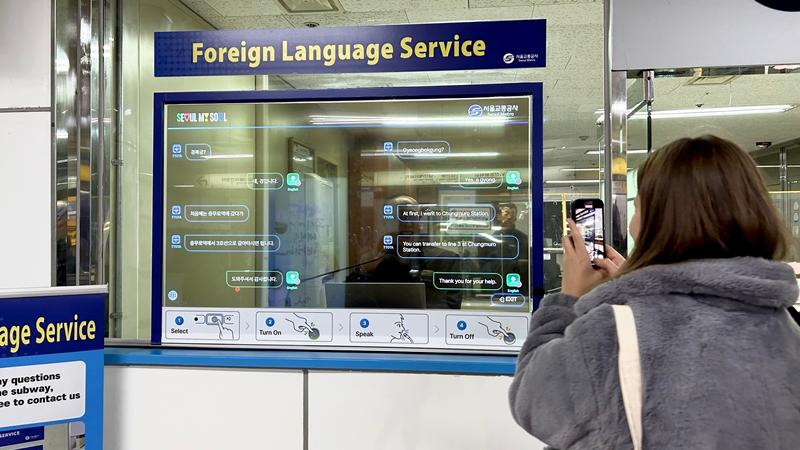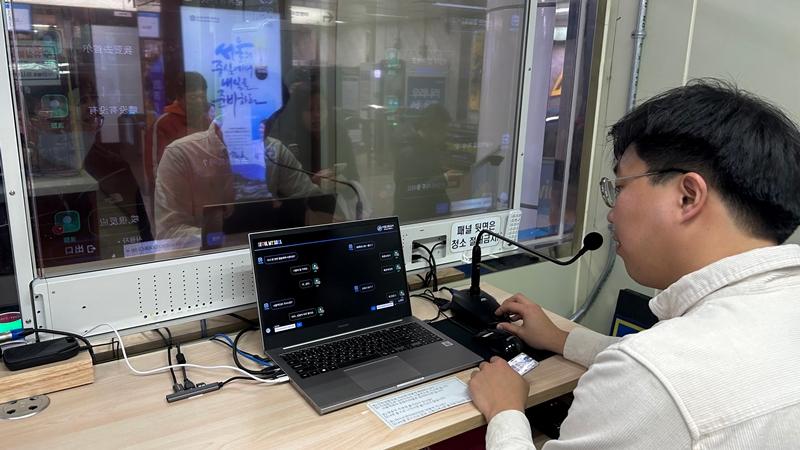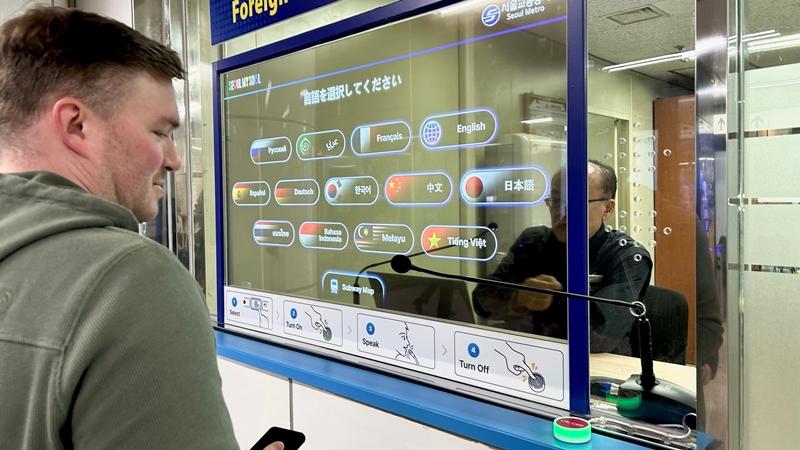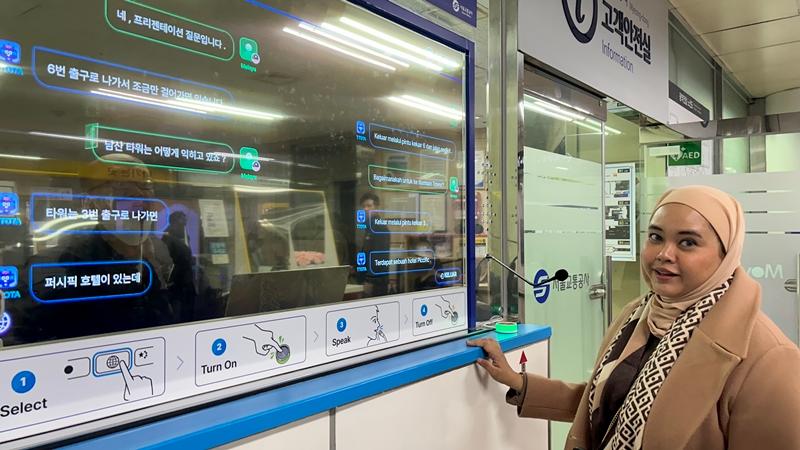
“너무 신기해요. 우리 나라에는 이런 것이 없거든요. 한국어나 영어를 할 줄 몰라도 자국 언어를 사용할 수 있어 편할 것 같아요.” “This is amazing. We don’t have anything like this in my country. Even if you can’t speak Korean or English, it seems convenient to use your mother tongue.”
튀르키예에서 온 칼데렌 코세 씨가 지난 12일 오후 서울 지하철 4호선 명동역에서 ‘외국어 동시 대화 시스템’을 처음 보고 한 말이다. 서울교통공사(이하 공사)가 지난 4일부터 시범 운영을 시작한 외국어 동시 대화 시스템은 AI 외국어 통역 시스템을 기반으로 외국인과 역무원의 원활한 소통을 제공하는 서비스다. 현재 13개 언어(아랍어, 중국어, 독일어, 영어, 스페인어, 프랑스어, 인도네시아어, 일본어, 한국어, 말레이시아어, 러시아어, 태국어, 베트남어)로 이용이 가능하다.
Kardelen Kose, a tourist from Turkiye (Turkey), on the afternoon of Dec. 12 said this after seeing the AI (Artificial Intelligence) Live-Translation System for the first time at Myeongdong Station on Seoul’s No. 4 subway line. Seoul Metro on Dec. 4 launched pilot operations of the real-time interpretation system, which is based on an AI system of foreign language interpretation to offer smooth communication between foreign nationals and subway staff. The 13 languages offered by the system are Arabic, Chinese, German, English, Spanish, French, Indonesian, Japanese, Korean, Malay, Russian, Thai and Vietnamese.

기자가 직접 외국어 동시 대화 시스템을 사용해 보니 사용법은 간단했다. 화면에서 영어를 선택하자 알림음이 울리며 역무원이 찾아왔고, 마이크 전원 버튼을 눌러 다음과 같이 말했다. “Where is the nearest restroom?” (가장 가까운 화장실이 어디죠?)
Using the system is easy. For example, selecting the English option on the screen caused a notification sound to go off and a subway worker to appear. A person pressed the button on the microphone and asked, “Where’s the nearest restroom?”
몇 초 뒤 55인치의 투명 디스플레이에 영어에서 한국어로 번역 된 문장이 표시됐다. 역무원은 방향을 가리키는 손짓과 함께 한국어로 “오른쪽 방향으로 가시면 됩니다”고 말하자 한국어에서 영어로 번역된 문장이 스크린에 띄워졌다. 네이버 파파고나 구글 번역기와 같은 상용 번역기와 달리 얼굴을 마주 보며 대화를 한 덕분에 역무원과 더욱 직관적인 의사소통을 할 수 있었다.
A few seconds later, an English-to-Korean translated sentence appeared on the 55-inch transparent screen. The subway worker pointed toward a desired direction and said, “Go to your right.” After finishing his sentence, a Korean-to-English translated sentence also appeared. Unlike commercial translation apps like Naver’s Papago or Google Translate, the AI-based system helps communicate with the subway worker more intuitively in an in-person conversation with eye contact and gestures.
최형채 명동역 역장은 “하루 평균 20~30여 명이 외국어 동시 대화 시스템 부스를 방문한다”며 “영어권을 비롯해 일본, 중국에서 온 여행객들이 주로 이용하고 있다”고 전했다.
“An average of 20-30 visitors visit the AI Live-Translation System daily,” Myeongdong Station manager Choi Hyeong-chae said. “Those who mainly use it aren’t just tourists from English-speaking countries but also those from Japan and China.”

이날 미국 미시간주에서 한국 여행을 온 에릭 메데마 씨는 부스에 설치된 마이크를 통해 역무원에게 영어로 “명동역에서 전쟁기념관을 어떻게 가나요?”라고 물었다. 역무원은 한국어로 번역된 문장을 보고 “여기서 회현역 방면으로 4호선 열차를 타신 뒤 삼각지역에서 내리시면 됩니다”고 안내했다.
On the same day, tourist Eric Medema from the U.S. state of Michigan asked through the microphone installed in the booth, “How can I go to the War Memorial of Korea from Myeongdong Station?” The staff member saw the English-to-Korean translated sentence and said, “Take Subway Line 4 towards Hoehyeon Station and get off at Samgakji Station.”
외국어 동시 대화 시스템을 써본 소감을 묻자 에릭 씨는 “지하철 노선도를 통해 보는 것보다 훨씬 편리하다”고 말했다. Medema called using the system far more convenient than a Seoul subway map.
최 역장은 외국어 동시 대화 시스템의 가장 큰 장점으로 “현장에서 언어장벽 없이 역무원과의 대화를 통해 사용자가 원하는 정보를 신속하게 얻을 수 있다는 점”을 꼽았다. 또한 소통이 어려운 한국인 청각장애인을 위해 한국어 서비스도 제공한다고 설명했다.
Choi said the greatest advantage of the system is its “ability to allow users to quickly obtain the information they need through conversations with station staff without language barriers.” He added that the service in Korean is for hearing-impaired Koreans who face difficulties in communication.

말레이시아 쿠알라룸푸르에서 온 니나 아밀라 씨는 “역무원이 직접 가이드를 제공해 도움이 되었고 다른 외국인들에게도 추천해 주고 싶다”고 사용 후기를 들려줬다. 이어 “아쉬운 부분이라면 말레이시아어의 경우 완전한 한 문장으로 말해야 번역기가 인식을 할 수 있고 표준어로만 사용해야 번역이 가능한 것 같다는 점”이라고 말했다.
Nina Amila from Kuala Lumpur, Malaysia, gave her take on using the system, saying the subway worker provided direct and helpful guidance and that she wished to recommend it to other foreign tourists. As for drawbacks, she said Malay speakers must use complete sentences for the device to recognize the speech and that it seems only standard versions of a language without dialect can be interpreted.
공사 관계자는 “내년 2월 서비스를 서울역, 홍대입구역, 광화문역, 이태원역 등 10개역으로 늘려 외국인들을 위한 정보 제공을 확대할 예정”이라며 “역 이름 등 고유명사 인식의 경우 AI 기반 데이터 수집 및 축적을 통해 개선할 방침”이라고 밝혔다.
“From February, the service will be expanded to 10 stations including those of Seoul, Hongik University, Gwanghwamun, and Itaewon to give more information to foreign nationals,” a Seoul Metro source said. “For the recognition of proper nouns like station names, upgrades will come through AI-based data collection and storage.”
서울 = 글·사진 최진우 기자 paramt@korea.kr
By Choi Jin-woo, paramt@korea.kr
Photos = Choi Jin-woo
